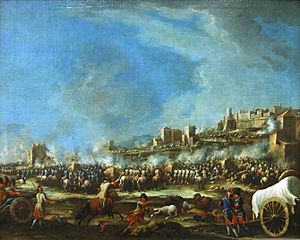Battle of Bitonto facts for kids
Quick facts for kids Battle of Bitonto |
|||||||
|---|---|---|---|---|---|---|---|
| Part of the War of the Polish Succession | |||||||
 The Battle of Bitonto by Giovanni Luigi Rocco |
|||||||
|
|||||||
| Belligerents | |||||||
| Commanders and leaders | |||||||
| Strength | |||||||
| 14,000 infantry and cavalry | 8,000 infantry 2,500 cavalry |
||||||
| Casualties and losses | |||||||
| 99 dead 196 wounded |
1,000 dead 1,000 wounded 2,500 captured |
||||||
The Battle of Bitonto was an important battle fought on May 25, 1734. It took place near the town of Bitonto in southern Italy. In this battle, the Spanish army won a big victory over the Austrian forces. This win helped Spain take control of the Kingdom of Naples during the War of the Polish Succession. After this battle, most Austrian resistance in the kingdom ended.
Contents
Why the Battle of Bitonto Happened
Spain's Goal: Reclaiming Italian Lands
King Philip V of Spain really wanted to get back Naples and Sicily. These lands were part of Italy and had been lost to the Austrian Habsburgs in an earlier war. In 1714, King Philip married Elisabeth Farnese. She also had family ties to Italy and wanted to see Spanish power grow there.
The War of the Polish Succession
When the War of the Polish Succession started in 1733, it was a perfect chance for Spain. The Habsburgs, who ruled Austria, didn't have much military help from other European countries. Great Britain and the Dutch Republic stayed neutral. Meanwhile, France and Charles Emmanuel III of Sardinia were actively against Austria.
Forming Alliances: The Bourbon Family Compact
In the fall of 1733, Spain and France signed a special agreement. It was called the Treaty of the Escorial. This was the first of several "Bourbon Family Compacts." These agreements promised that Spain and France would protect and help each other. They also agreed to work together to conquer Habsburg lands in Italy.
The Spanish March to Naples
A Spanish fleet, led by Luis de Córdova y Córdova, landed an army in Genoa. This army then joined forces with troops led by Charles of Parma. Charles was the eldest son of King Philip V and Elisabeth. Together, about 21,000 Spanish soldiers marched through the Papal States without any trouble.
They headed straight for Naples. On May 7, 1734, Charles entered Naples almost without a fight. He then declared himself the new king of the Two Sicilies.
Austrian Retreat and Preparations
The Austrian leader, Viceroy Guido Visconti, first ran away to Bari. Then, on May 21, he left by ship. He left Giuseppe Antonio, Prince of Belmonte in charge of the remaining Austrian forces. The retreating Austrians got some new soldiers from Sicily and some recruits from Taranto.
Belmonte knew the Spanish might get more troops from their fleet. So, he moved his army to Bitonto on May 24. He wanted to force a battle before the Spanish army grew even bigger. He used low walls and two monasteries in the town as defenses. Belmonte waited for the Spanish to arrive. The Spanish army, led by Duke of Montemar, had about 14,000 experienced soldiers.
The Battle of Bitonto
Spanish Attack and Austrian Defense
At sunrise on May 25, the Spanish army arrived. Duke of Montemar arranged his soldiers. Infantry faced infantry, and cavalry faced cavalry. The Spanish had many more cavalry soldiers, so some were kept ready on the right side. The Spanish tried a few tricks to make the Austrians leave their defenses. Then, the main attack began.
The Austrian Collapse
Around 10 AM, the Austrian cavalry finally broke apart. Most of them started a messy retreat towards Bari. Soon after, Prince Belmonte also fled. The rest of the Austrian army then fell apart. Some soldiers followed the cavalry, while others tried to escape north or into Bitonto.
The Austrian soldiers defending the two monasteries fought hard. But the Spanish stormed these defenses and took them over. The Austrian soldiers inside the city of Bitonto surrendered the next day. They ran out of ammunition and supplies.
What Happened After the Battle
Austrian Surrender and Spanish Control
Prince Belmonte tried to gather his remaining forces in Bari. But the local people were supporting the Spanish, which made it very difficult. In the end, Belmonte surrendered about 3,800 men to the local authorities. A few hundred Austrian soldiers who escaped the battle managed to reach Pescara. This city had not yet been taken by the Spanish.
Other cities in the Kingdom of Naples soon recognized Spanish rule. Only two Austrian-held fortresses kept fighting until the autumn. Gaeta had been surrounded early in the conflict and held out until August. Traun defended Capua until November 30. He finally surrendered, and his soldiers marched out with full military honors.
Peace and Commemoration
The return of the Two Sicilies to Spain was officially confirmed in 1738. This happened with the Treaty of Vienna, which ended the war. Charles, the new king, honored Montemar by naming him Duke of Bitonto. He also asked Giovanni Antonio Medrano to build an obelisk on the battlefield. This monument was built to remember the important Spanish victory.
See also
 In Spanish: Batalla de Bitonto para niños
In Spanish: Batalla de Bitonto para niños


